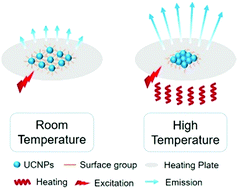Discovery of non-reversible thermally enhanced upconversion luminescence behavior in rare-earth doped nanoparticles†
Abstract
Thermal quenching is quite usual in different luminescent materials due to enhanced phonon population, while anti-thermal quenching or thermally enhanced luminescence does exist in a few systems, which is intrinsically associated with the presence of thermally coupled energy levels or a phase transition. However, we show here that an extrinsic effect involving volatilization of surface moieties contributes to switchable enhancement of upconversion (UC) at elevated temperatures. We observe this abnormal thermally enhanced UC behavior in a typical UC system, NaGdF4:Yb,Tm nanoparticles, which are coated with moieties that are unstable at elevated temperatures. Unlike low-temperature UC behavior, this thermally enhanced emission process is not completely reversible during several heating–cooling cycles, and the volatilization/condensation of environmental moieties on the particle surfaces contributes to the reversible enhancement of the UC emission at elevated temperatures. Combined with numerical simulation, we clarify that the phonon-assisted nonradiative decay rates are greatly suppressed at high temperatures due to the volatilization of the adsorbed moieties, leading to the enhancement of the UC quantum efficiency. By deliberately blocking the surface processes, the thermally enhanced UC emission disappears completely and the thermal quenching process re-appears as usual.



 Please wait while we load your content...
Please wait while we load your content...